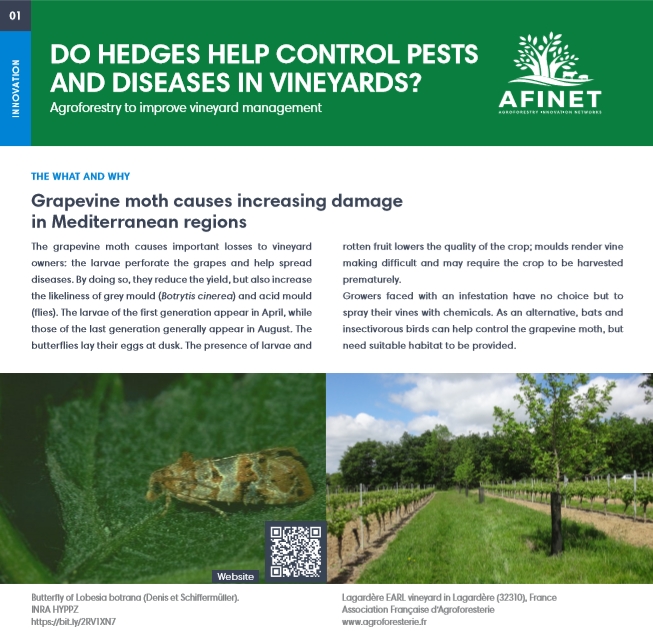 |
01 Do hedges help control pests and diseases in vineyards? The grapevine moth causes important losses to vineyard owners: the larvae perforate the grapes and help spread diseases. By doing so, they reduce the yield, but also increase the likeliness of grey mould ("Botrytis cinerea") and acid mould (flies). |
|
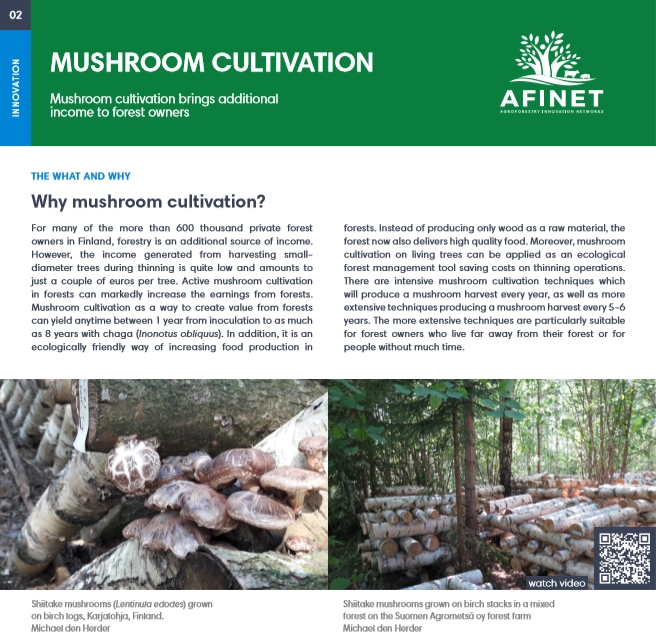 |
For many of the more than 600 thousand private forest owners in Finland, forestry is an additional source of income. However, the income generated from harvesting smalldiameter trees during thinning is quite low and amounts to just a couple of euros per tree. Active mushroom cultivation in forests can markedly increase the earnings from forests. |
|
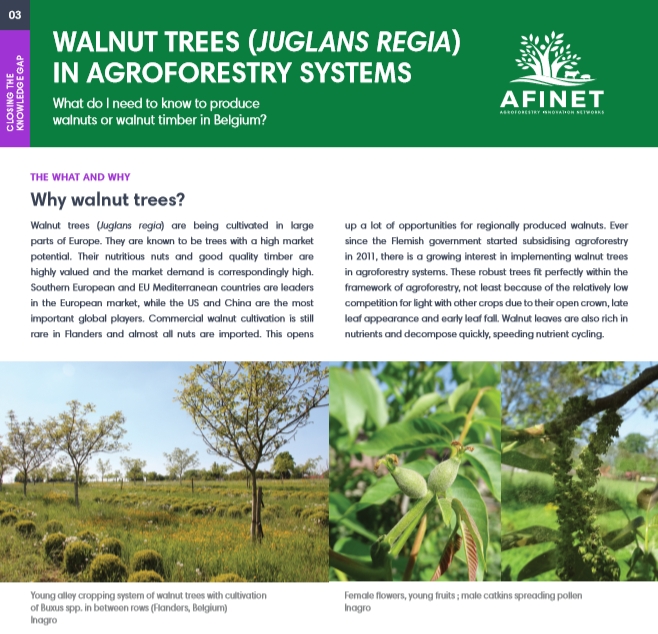 |
03 Walnut trees ("Juglans regia") in agroforestry systems Walnut trees ("Juglans regia") are being cultivated in large parts of Europe. They are known to be trees with a high market potential. Their nutritious nuts and good quality timber are highly valued and the market demand is correspondingly high. Southern European and EU Mediterranean countries are leaders in the European market, while the US and China are the most important global players. Commercial walnut cultivation is still rare in Flanders and almost all nuts are imported. Download the high resolution print version (available soon) |
|
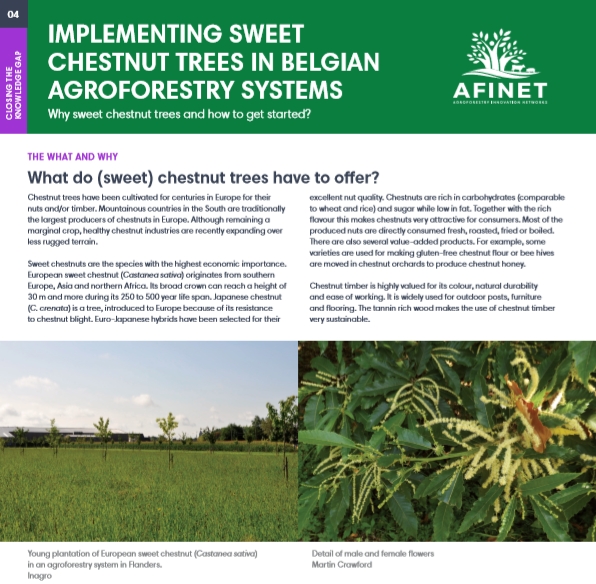 |
04 Implementing sweet chestnut trees in Belgian agroforestry systems Chestnut trees have been cultivated for centuries in Europe for their nuts and/or timber. Mountainous countries in the South are traditionally the largest producers of chestnuts in Europe. Although remaining a marginal crop, healthy chestnut industries are recently expanding over less rugged terrain. Download the high resolution print version (available soon) |
|
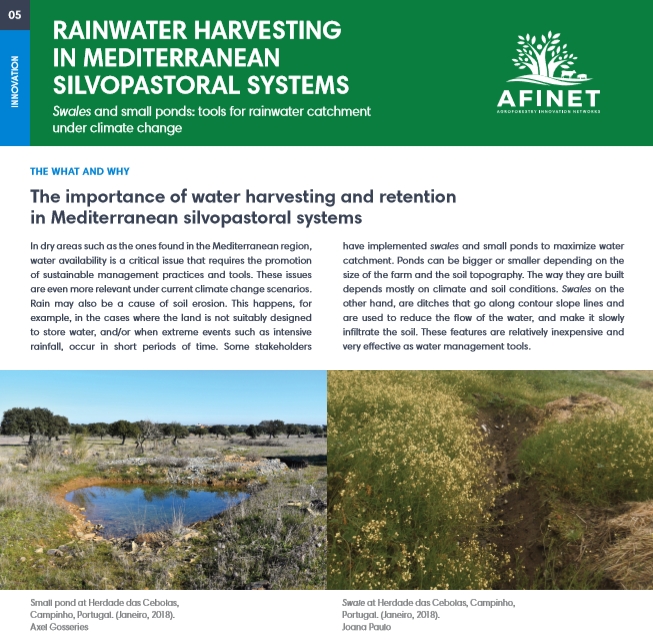 |
05 Rainwater harvesting in mediterranean silvopastoral systems In dry areas such as the ones found in the Mediterranean region, water availability is a critical issue that requires the promotion of sustainable management practices and tools. These issues are even more relevant under current climate change scenarios. Download the high resolution print version (available soon) |
|
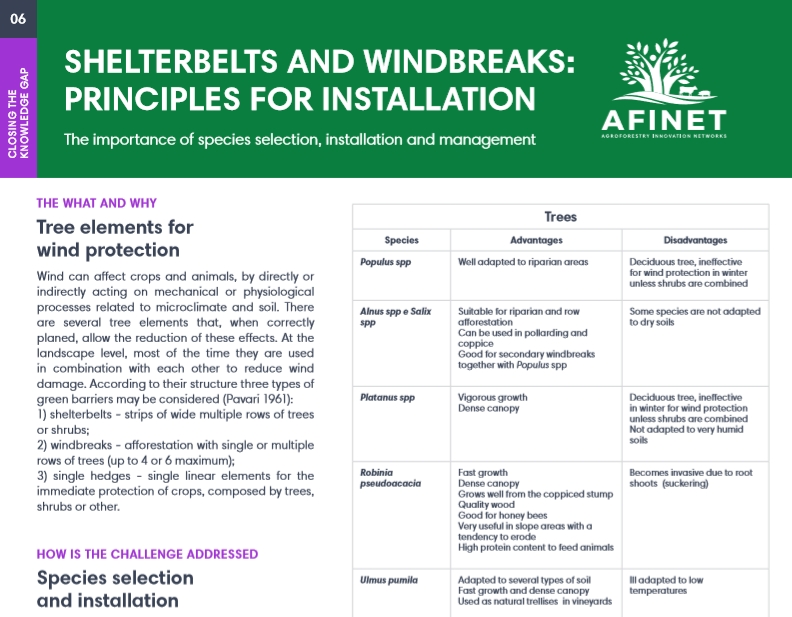 |
06 Shelterbelts and windbreaks: principles for installation Wind can affect crops and animals, by directly or indirectly acting on mechanical or physiological processes related to microclimate and soil. There are several tree elements that, when correctly planed, allow the reduction of these effects. At the landscape level, most of the time they are used in combination with each other to reduce wind damage. Download the high resolution print version (available soon) |
|
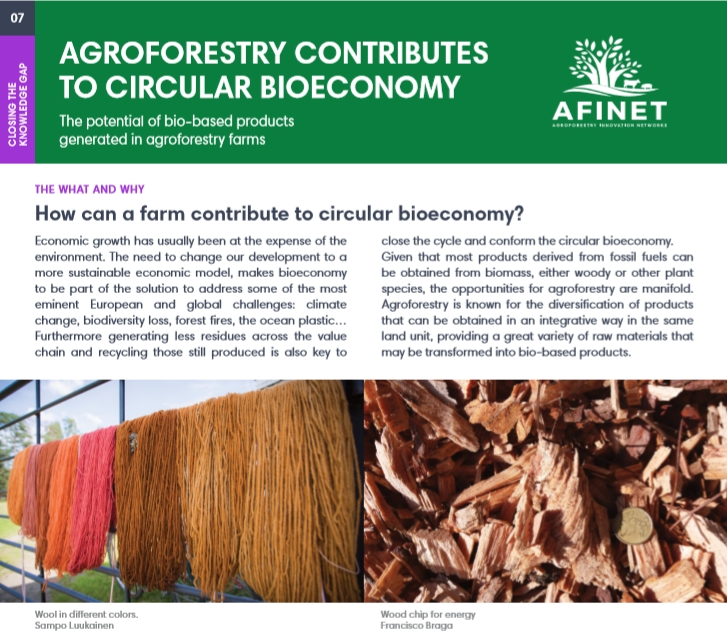 |
07 Agroforestry contributes to circular bioeconomy Economic growth has usually been at the expense of the environment. The need to change our development to a more sustainable economic model, makes bioeconomy to be part of the solution to address some of the most eminent European and global challenges: climate change, biodiversity loss, forest fires, the ocean plastic… |
|
 |
08 Using olive leaves by-products in grazed orchards Olive leaves are fibrous with a low digestibility, especially in crude protein, and they promote very poor rumen fermentation. However, if adequately supplemented, they may be successfully used in animal diets mostly fresh when the nutritive value of olive tree leaves is greater. |
|
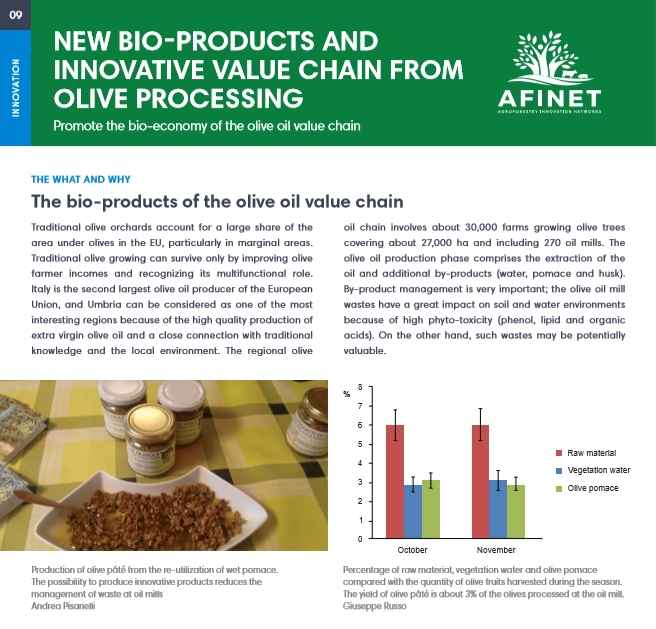 |
09 New bio-products and innovative value chain from olive processing Traditional olive orchards account for a large share of the area under olives in the EU, particularly in marginal areas. Traditional olive growing can survive only by improving olive farmer incomes and recognizing its multifunctional role. |
|
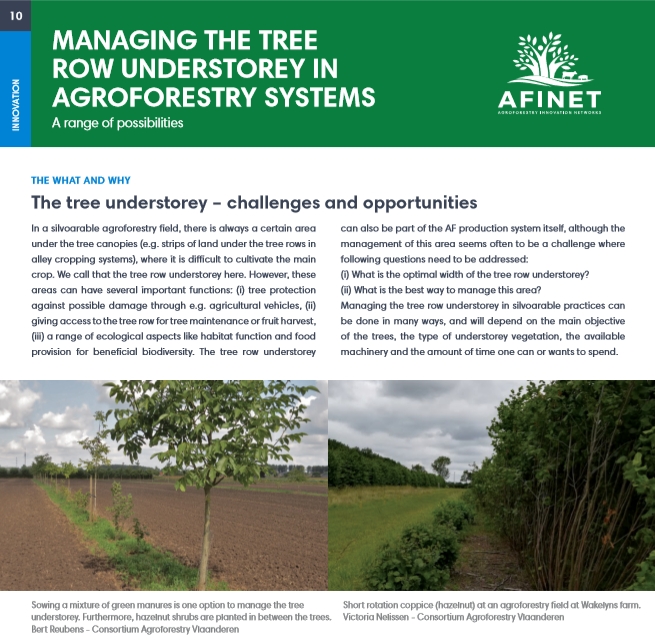 |
10 Managing the tree row understorey in agroforestry systems In a silvoarable agroforestry field, there is always a certain area under the tree canopies (e.g. strips of land under the tree rows in alley cropping systems), where it is difficult to cultivate the main crop. We call that the tree row understorey here. However, these areas can have several important functions: (i) tree protection against possible damage through e.g. agricultural vehicles, (ii) giving access to the tree row for tree maintenance or fruit harvest, (iii) a range of ecological aspects like habitat function and food provision for beneficial biodiversity. Download the high resolution print version (available soon) |
|
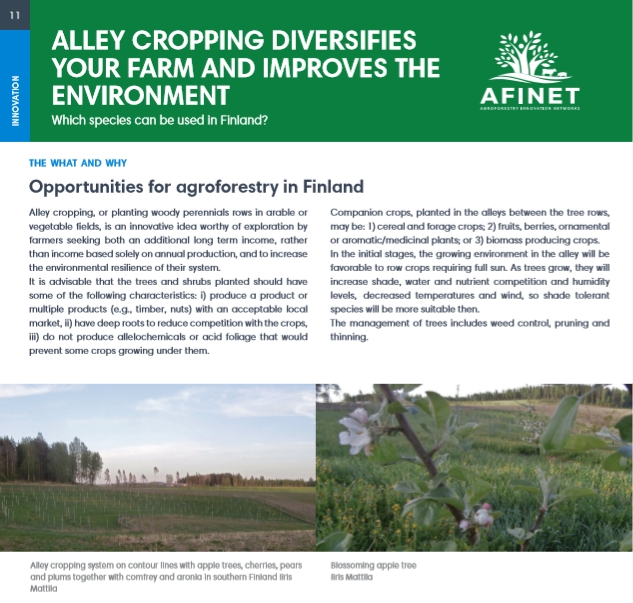 |
11 Alley cropping diversifies your farm and improves the environment Alley cropping, or planting woody perennials rows in arable or vegetable fields, is an innovative idea worthy of exploration by farmers seeking both an additional long term income, rather than income based solely on annual production, and to increase the environmental resilience of their system. |
|
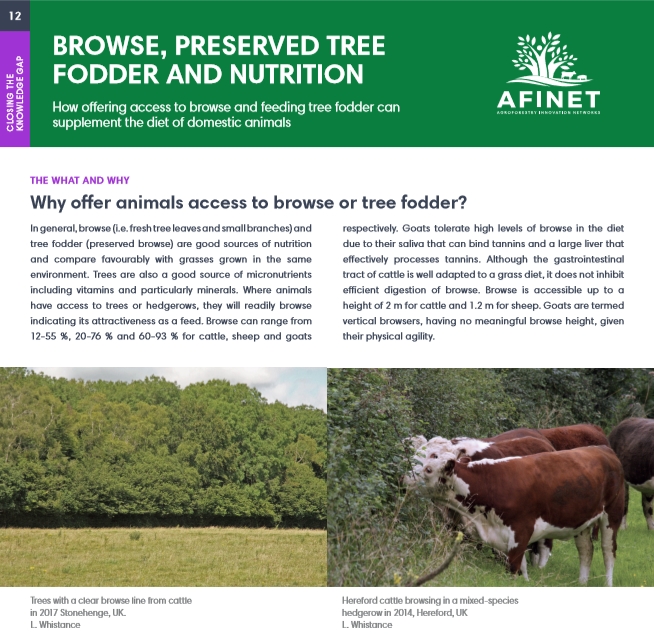 |
12 Browse, preserved tree fodder and nutrition In general, browse (i.e. fresh tree leaves and small branches) and tree fodder (preserved browse) are good sources of nutrition and compare favourably with grasses grown in the same environment. Trees are also a good source of micronutrients including vitamins and particularly minerals. |
|
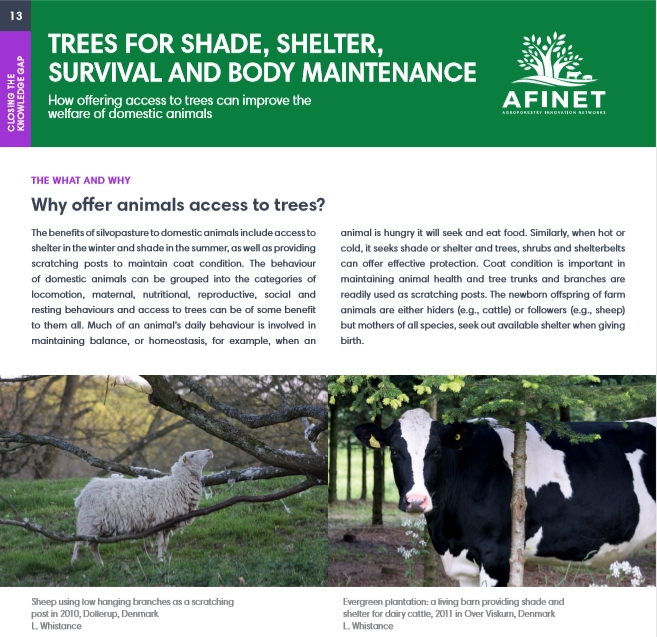 |
13 Trees for shade, shelter, survival and body maintenance The benefits of silvopasture to domestic animals include access to shelter in the winter and shade in the summer, as well as providing scratching posts to maintain coat condition. The behaviour of domestic animals can be grouped into the categories of locomotion, maternal, nutritional, reproductive, social and resting behaviours and access to trees can be of some benefit to them all. |
|
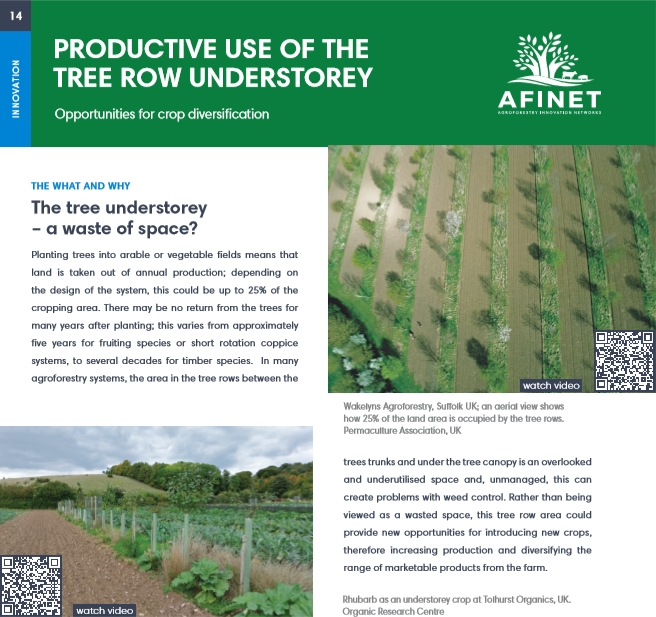 |
14 Productive use of the tree row understorey Planting trees into arable or vegetable fields means that land is taken out of annual production; depending on the design of the system, this could be up to 25% of the cropping area. |
|
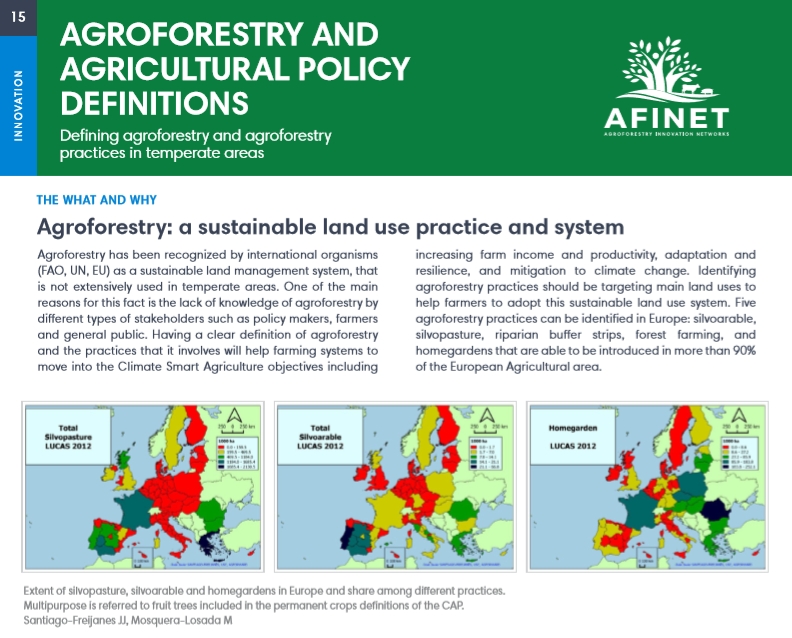 |
15 Agroforestry and agricultural policy definitions Agroforestry has been recognized by international organisms (FAO, UN, EU) as a sustainable land management system, that is not extensively used in temperate areas. One of the main reasons for this fact is the lack of knowledge of agroforestry by different types of stakeholders such as policy makers, farmers and general public. Download the high resolution print version (available soon) |
|
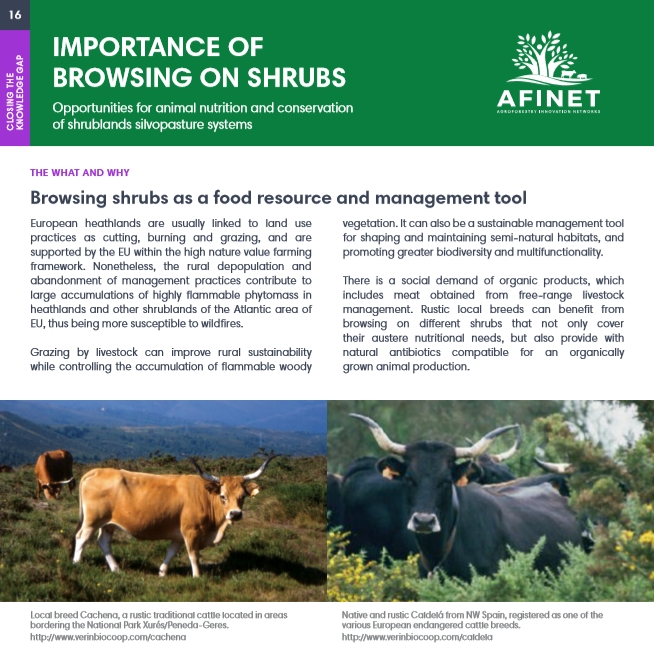 |
16 Importance of browsing on shrubs European heathlands are usually linked to land use practices as cutting, burning and grazing, and are supported by the EU within the high nature value farming framework. Nonetheless, the rural depopulation and abandonment of management practices contribute to large accumulations of highly flammable phytomass in heathlands and other shrublands of the Atlantic area of EU, thus being more susceptible to wildfires. Download the high resolution print version (available soon) |
|
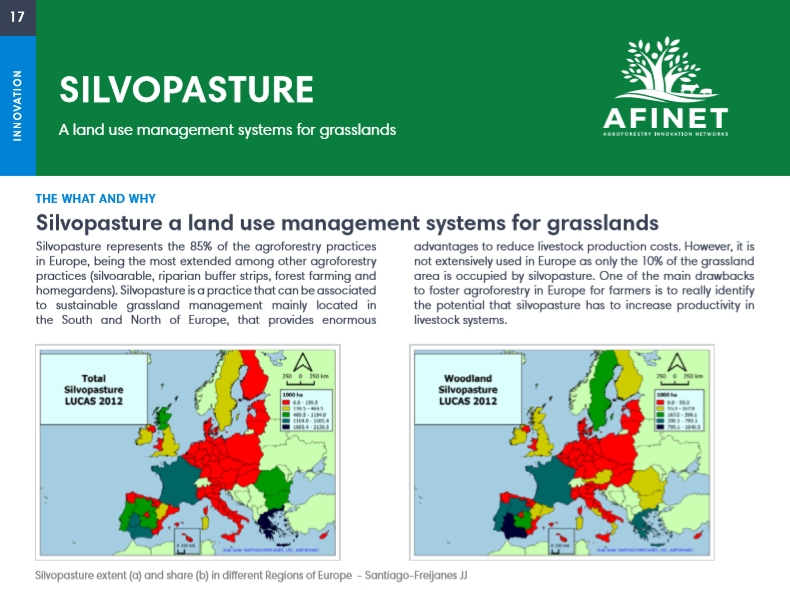 |
Silvopasture represents the 85% of the agroforestry practices in Europe, being the most extended among other agroforestry practices (silvoarable, riparian buffer strips, forest farming and homegardens). Silvopasture is a practice that can be associated to sustainable grassland management mainly located in the South and North of Europe, that provides enormous advantages to reduce livestock production costs. Download the high resolution print version (available soon) |
|
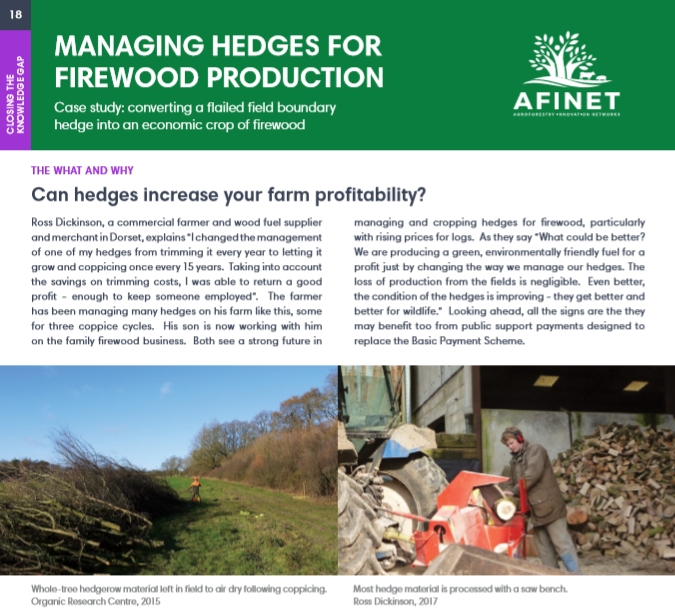 |
18 Managing hedges for firewood production Ross Dickinson, a commercial farmer and wood fuel supplier and merchant in Dorset, explains “I changed the management of one of my hedges from trimming it every year to letting it grow and coppicing once every 15 years. Taking into account the savings on trimming costs, I was able to return a good profit - enough to keep someone employed”. |
|
 |
19 Collaboration for successful agroforestry systems Most existing agroforestry systems on UK farms have been established by the farmer who is also the landowner or tenant. However, many famers lack both the time and the specialist knowledge to plant and care for trees and the capital to invest. |
|
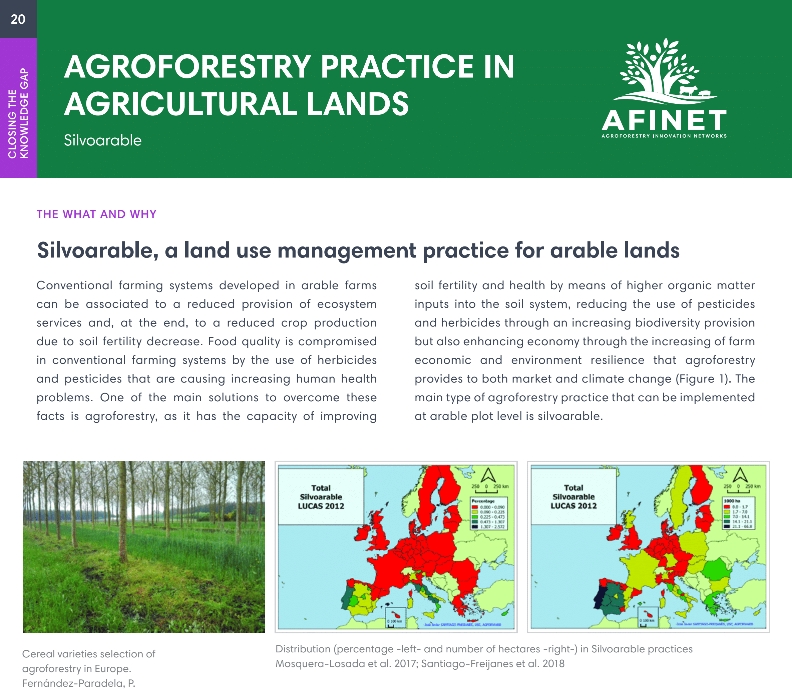 |
20 Agroforestry practice in agricultural lands Conventional farming systems developed in arable farms can be associated to a reduced provision of ecosystem services and, at the end, to a reduced crop production due to soil fertility decrease. Food quality is compromised in conventional farming systems by the use of herbicides and pesticides that are causing increasing human health problems. Download the high resolution print version (available soon) |
|
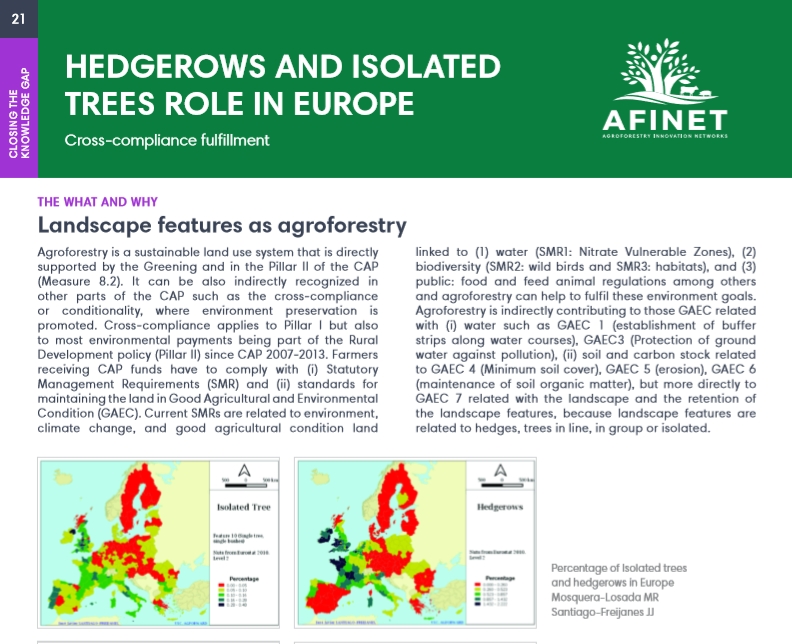 |
21 Hedgerows and isolated trees role in Europe Agroforestry is a sustainable land use system that is directly supported by the Greening and in the Pillar II of the CAP (Measure 8.2). It can be also indirectly recognized in other parts of the CAP such as the cross-compliance or conditionality, where environment preservation is promoted. Download the high resolution print version (available soon) |
|
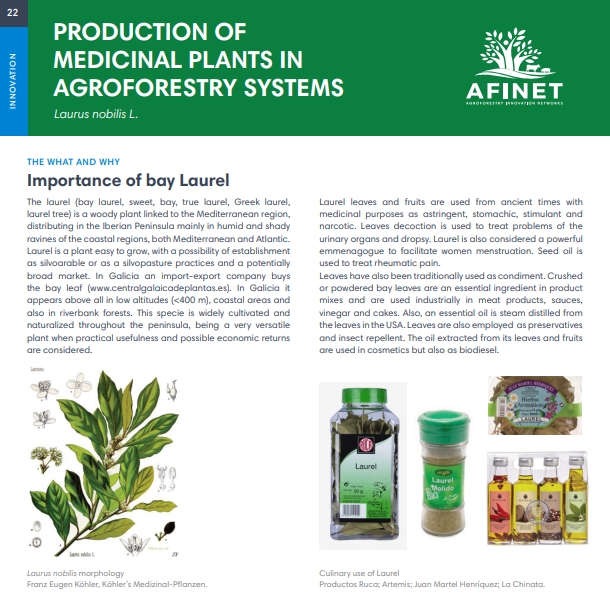 |
22 Production of medicinal plants in agroforestry systems The laurel (bay laurel, sweet, bay, true laurel, Greek laurel, laurel tree) is a woody plant linked to the Mediterranean region, distributing in the Iberian Peninsula mainly in humid and shady ravines of the coastal regions, both Mediterranean and Atlantic. Laurel is a plant easy to grow, with a possibility of establishment as silvoarable or as a silvopasture practices and a potentially broad market Download the high resolution print version (available soon) |
|
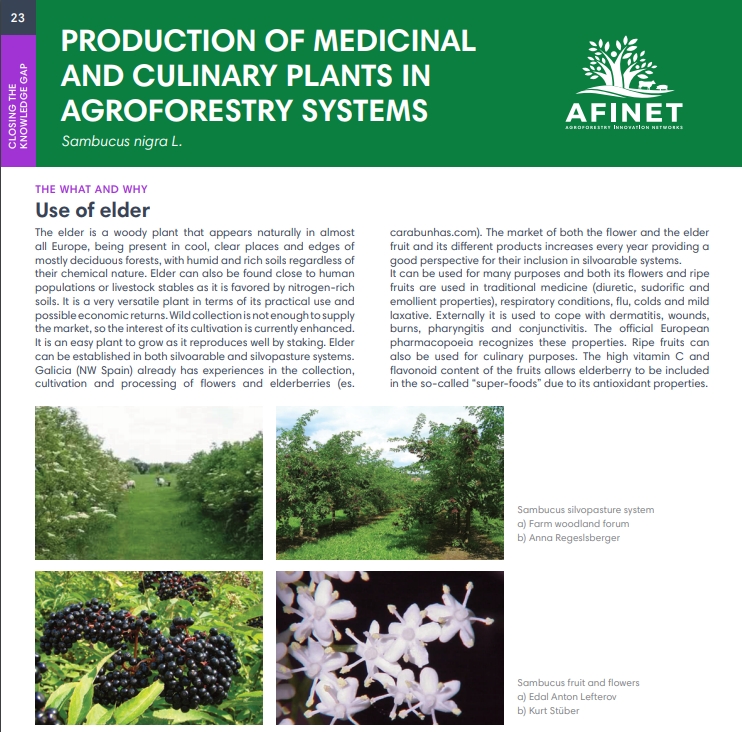 |
23 Production of medicinal and culinary plants in agroforestry systems The elder is a woody plant that appears naturally in almost all Europe, being present in cool, clear places and edges of mostly deciduous forests, with humid and rich soils regardless of their chemical nature. Elder can also be found close to human populations or livestock stables as it is favored by nitrogen-rich soils. Download the high resolution print version (available soon) |
|
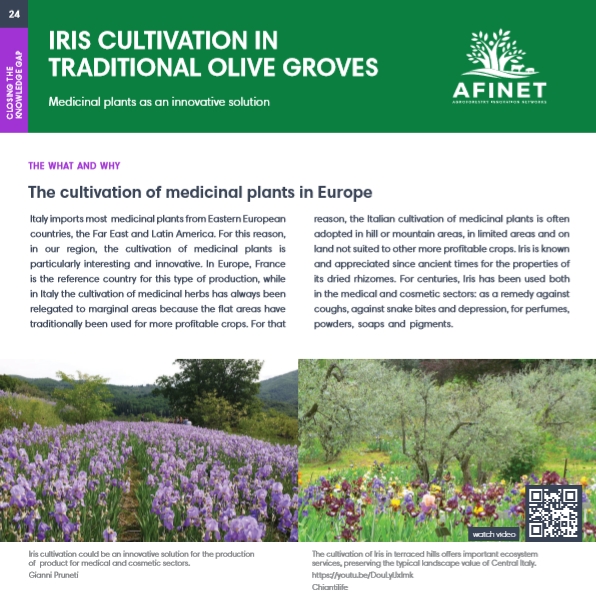 |
24 Iris cultivation in traditional olive groves Italy imports most medicinal plants from Eastern European countries, the Far East and Latin America. For this reason, in our region, the cultivation of medicinal plants is particularly interesting and innovative. In Europe, France is the reference country for this type of production, while in Italy the cultivation of medicinal herbs has always been relegated to marginal areas because the flat areas have traditionally been used for more profitable crops. |
|
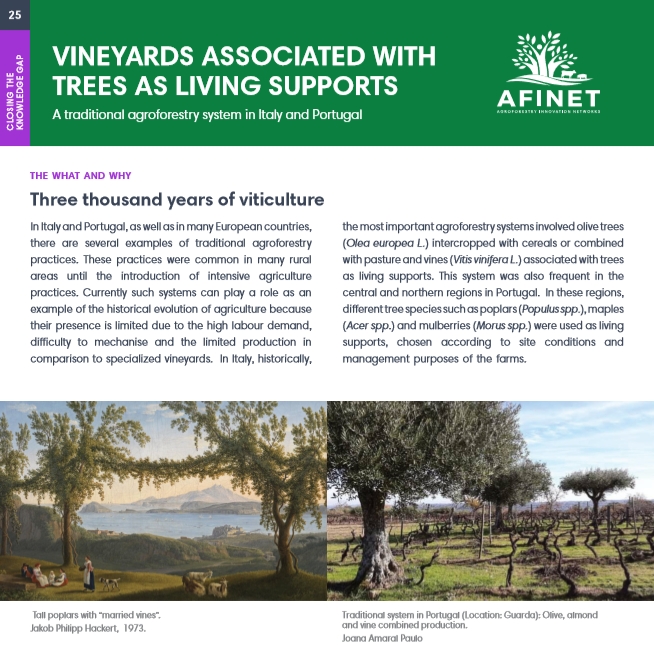 |
25 Vineyards associated with trees as living supports In Italy and Portugal, as well as in many European countries, there are several examples of traditional agroforestry practices. These practices were common in many rural areas until the introduction of intensive agriculture practices. Currently such systems can play a role as an example of the historical evolution of agriculture because their presence is limited due to the high labour demand, difficulty to mechanise and the limited production in comparison to specialized vineyards. |
|
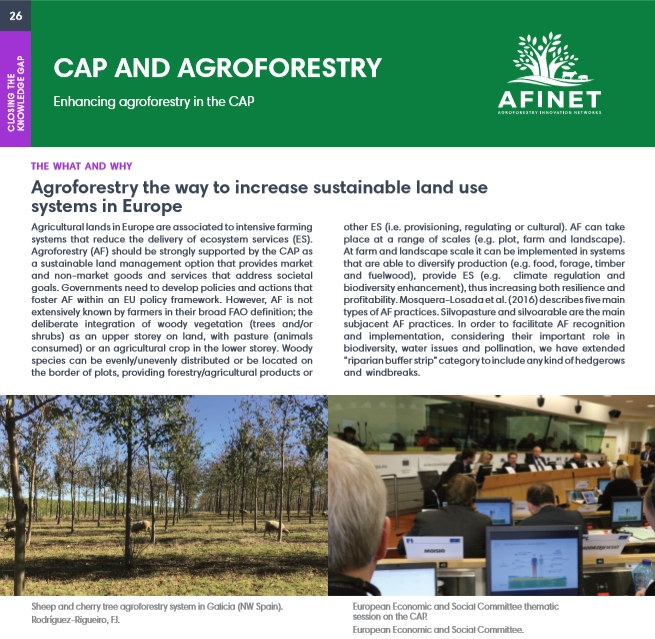 |
Agricultural lands in Europe are associated to intensive farming systems that reduce the delivery of ecosystem services (ES). Agroforestry (AF) should be strongly supported by the CAP as a sustainable land management option that provides market and non-market goods and services that address societal goals. Governments need to develop policies and actions that foster AF within an EU policy framework. Download the high resolution print version (available soon) |
|
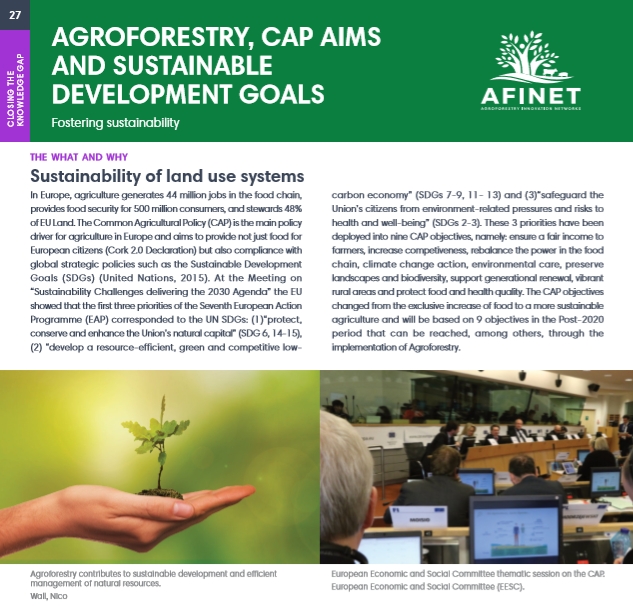 |
27 Agroforestry, CAP aims and sustainable development goals In Europe, agriculture generates 44 million jobs in the food chain, provides food security for 500 million consumers, and stewards 48% of EU Land. The Common Agricultural Policy (CAP) is the main policy driver for agriculture in Europe and aims to provide not just food for European citizens (Cork 2.0 Declaration) but also compliance with global strategic policies such as the Sustainable Development Goals (SDGs) (United Nations, 2015). Download the high resolution print version (available soon) |
|
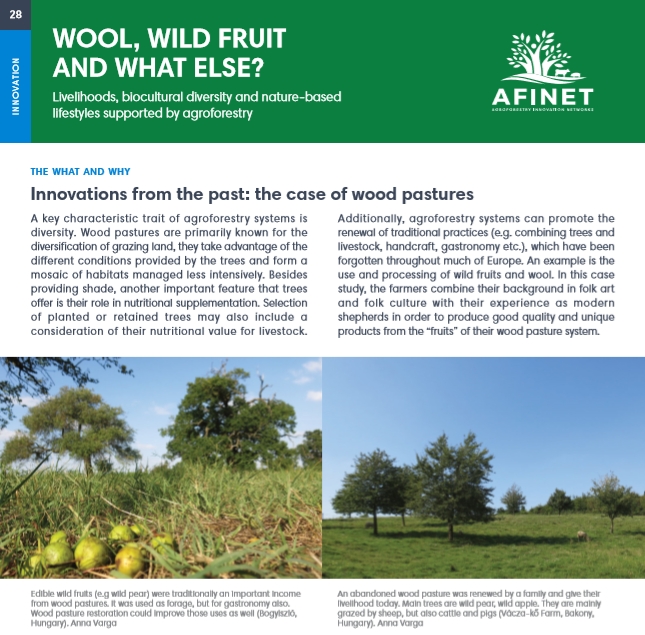 |
28 Wool, wild fruit and what else? A key characteristic trait of agroforestry systems is diversity. Wood pastures are primarily known for the diversification of grazing land, they take advantage of the different conditions provided by the trees and form a mosaic of habitats managed less intensively. Besides providing shade, another important feature that trees offer is their role in nutritional supplementation. |
|
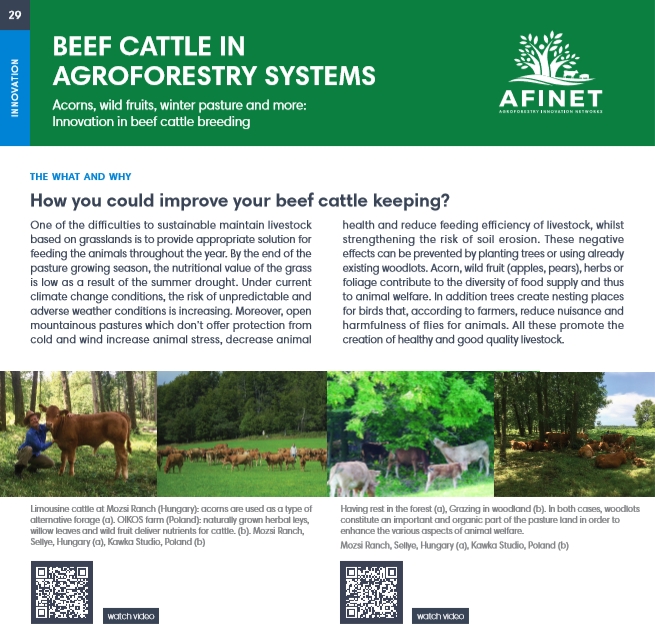 |
29 Beef cattle in agroforestry systems One of the difficulties to sustainable maintain livestock based on grasslands is to provide appropriate solution for feeding the animals throughout the year. By the end of the pasture growing season, the nutritional value of the grass is low as a result of the summer drought. Under current climate change conditions, the risk of unpredictable and adverse weather conditions is increasing. |
|
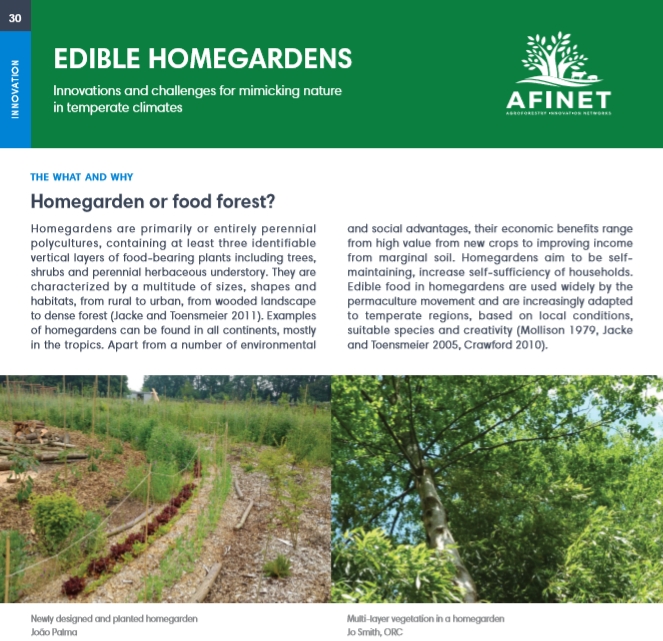 |
Homegardens are primarily or entirely perennial polycultures, containing at least three identifiable vertical layers of food-bearing plants including trees, shrubs and perennial herbaceous understory. They are characterized by a multitude of sizes, shapes and habitats, from rural to urban, from wooded landscape to dense forest (Jacke and Toensmeier 2011). Download the high resolution print version (available soon) |
|
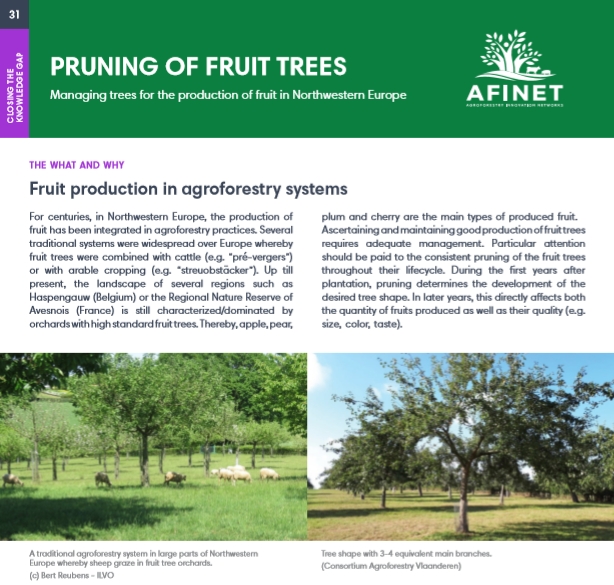 |
For centuries, in Northwestern Europe, the production of fruit has been integrated in agroforestry practices. Several traditional systems were widespread over Europe whereby fruit trees were combined with cattle (e.g. “pré-vergers”) or with arable cropping (e.g. “streuobstäcker”). Download the high resolution print version (available soon) |
|
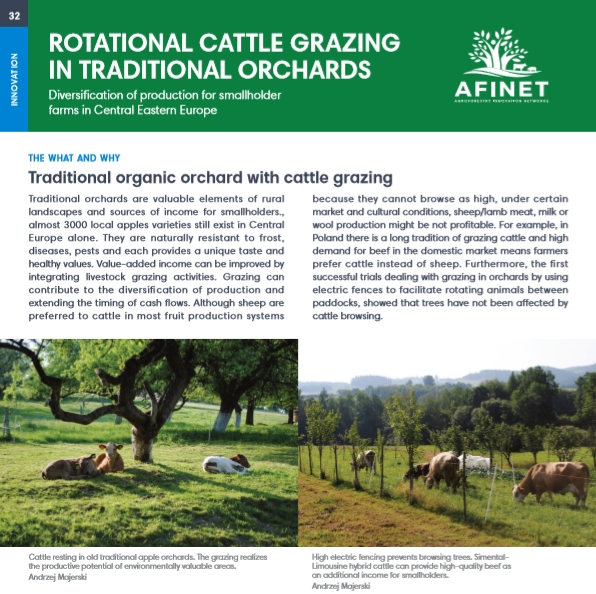 |
32 Rotational cattle grazing in traditional orchards Traditional orchards are valuable elements of rural landscapes and sources of income for smallholders., almost 3000 local apples varieties still exist in Central Europe alone. They are naturally resistant to frost, diseases, pests and each provides a unique taste and healthy values. Value-added income can be improved by integrating livestock grazing activities. Download the high resolution print version (available soon) |
|
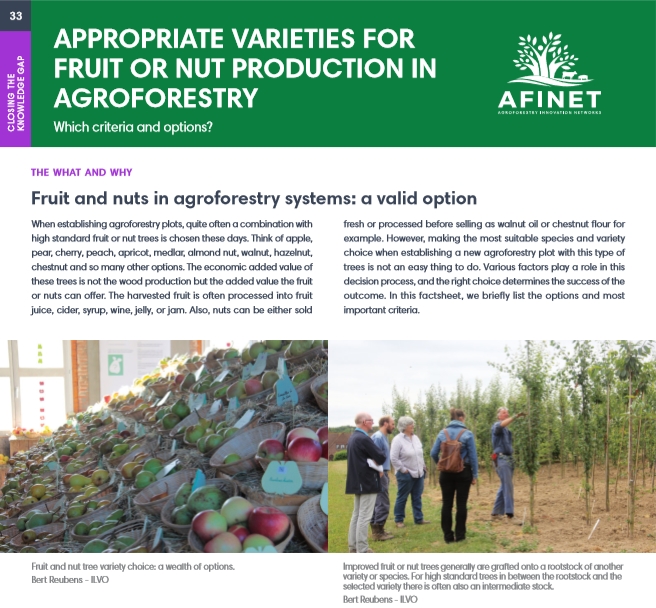 |
33 Appropriate varieties for fruit or nut production in agroforestry When establishing agroforestry plots, quite often a combination with high standard fruit or nut trees is chosen these days. Think of apple, pear, cherry, peach, apricot, medlar, almond nut, walnut, hazelnut, chestnut and so many other options. The economic added value of these trees is not the wood production but the added value the fruit or nuts can offer. Download the high resolution print version (available soon) |
|
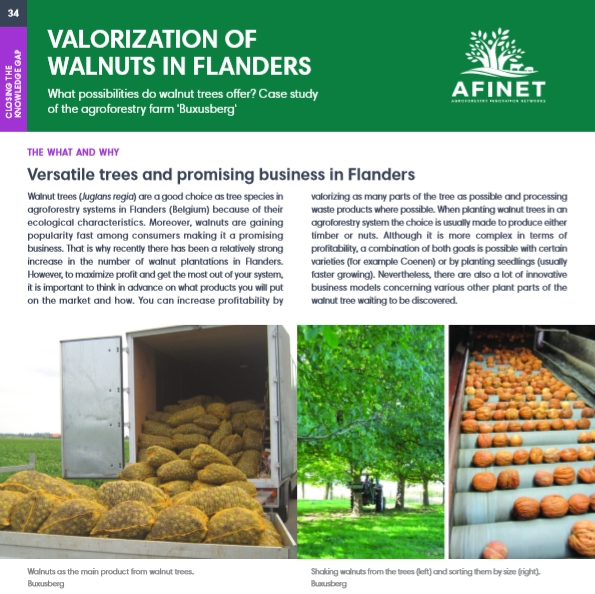 |
34 Valorization of walnuts in Flanders Walnut trees (Juglans regia) are a good choice as tree species in agroforestry systems in Flanders (Belgium) because of their ecological characteristics. Moreover, walnuts are gaining popularity fast among consumers making it a promising business. That is why recently there has been a relatively strong increase in the number of walnut plantations in Flanders. Download the high resolution print version (available soon) |
|
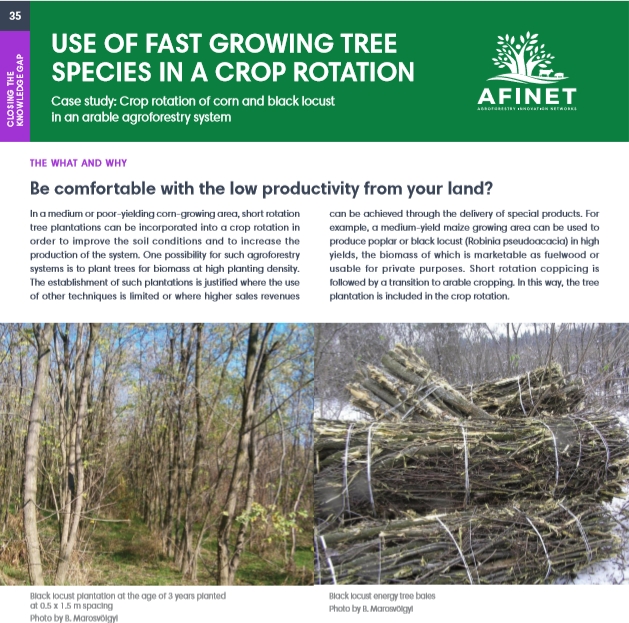 |
35 Use of fast growing tree species in a crop rotation In a medium or poor-yieldingcorn-growing area, short rotation tree plantations can be incorporated into a crop rotation in order to improve the soil conditions and to increase the production of the system. One possibility for such agroforestry systems is to plant trees for biomass at high planting density. |
|
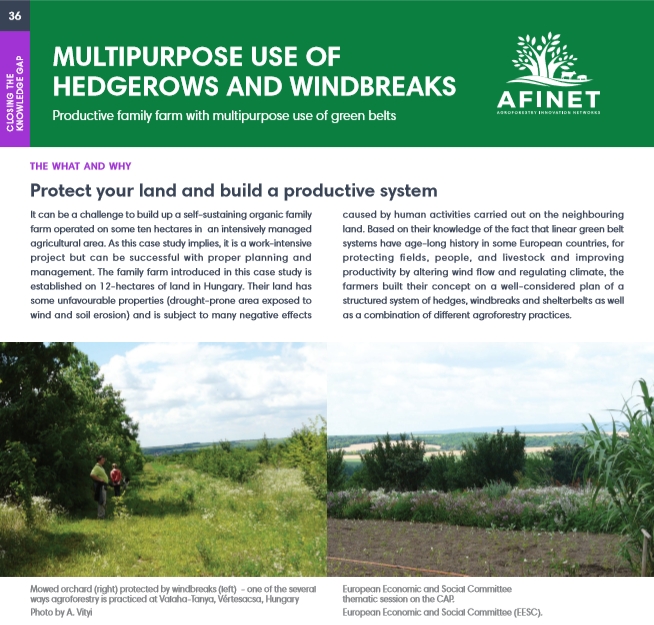 |
36 Multipurpose use of hedgerows and windbreaks It can be a challenge to build up a self-sustaining organic family farm operated on some ten hectares in an intensively managed agricultural area. As this case study implies, it is a work-intensive project but can be successful with proper planning and management. The family farm introduced in this case study is established on 12-hectares of land in Hungary. |
|
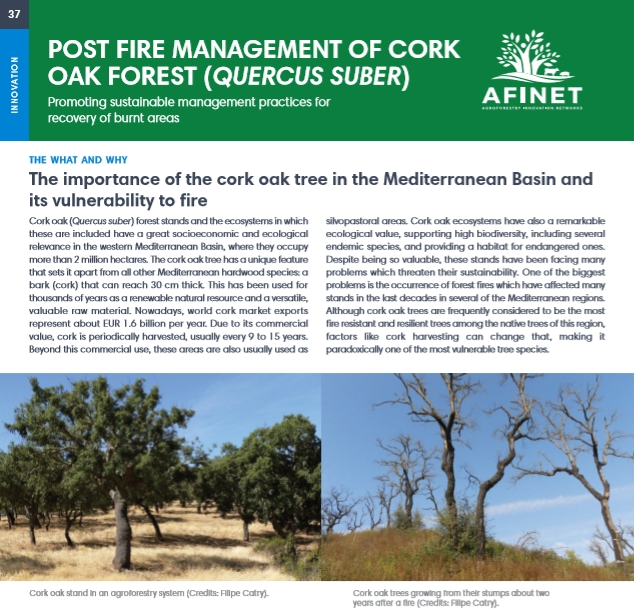 |
37 Post-fire management of cork oak forest (Quercus suber) Corkoak (Quercus suber) forestst and sand the ecosystems in which these are included have a great socioeconomic and ecological relevance in the western Mediterranean Basin, where they occupy more than 2 million hectares. The cork oak tree has a unique feature that sets it apart from all other Mediterranean broadleaved species: a bark (cork) that can reach 30 cm thick. Download the high resolution print version (available soon) |
|
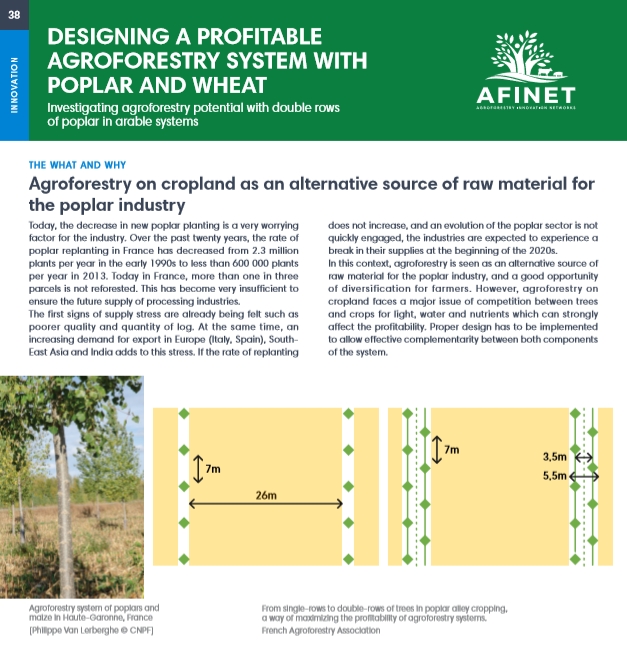 |
38 Designing a profitable agroforestry system with poplar and wheat Today, the decrease in new poplar planting is a very worrying factor for the industry. Over the past twenty years, the rate of poplar replanting in France has decreased from 2.3 million plants per year in the early 1990s to less than 600 000 plants per year in 2013. Today in France, more than one in three parcels is not reforested. This has become very insufficient to ensure the future supply of processing industries. |
|
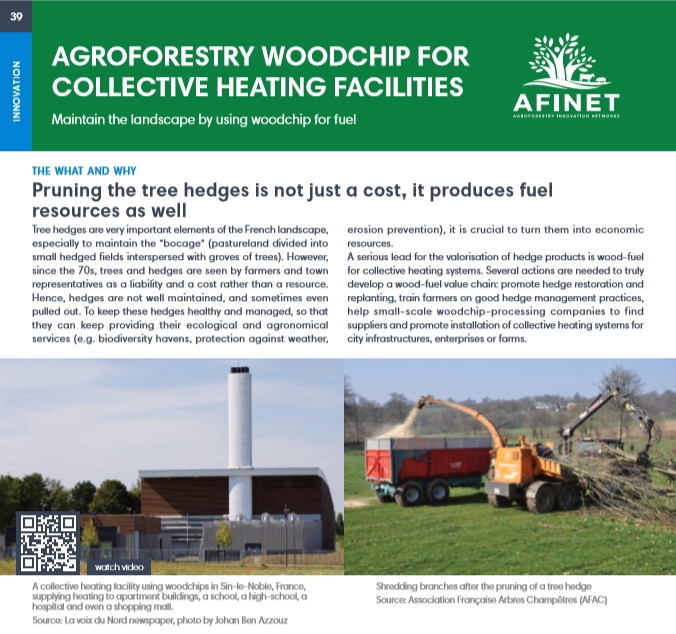 |
39 Agroforestry woodchip for collective heating facilities Tree hedges are very important elements of the French landscape, especially to maintain the “bocage” (pastureland divided into small hedged fields interspersed with groves of trees). However, since the 70s, trees and hedges are seen by farmers and town representatives as a liability and a cost rather than a resource. |
|
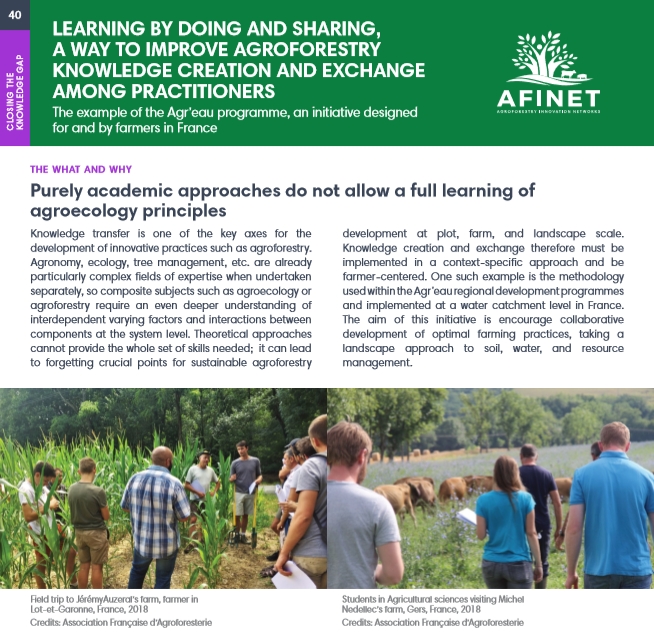 |
Knowledge transfer is one of the key axes for the development of innovative practices such as agroforestry. Agronomy, ecology, tree management, etc. are already particularly complex fields of expertise when undertaken separately, so composite subjects such as agroecology or agroforestry require an even deeper understanding of interdependent varying factors and interactions between components at the system level. |
|
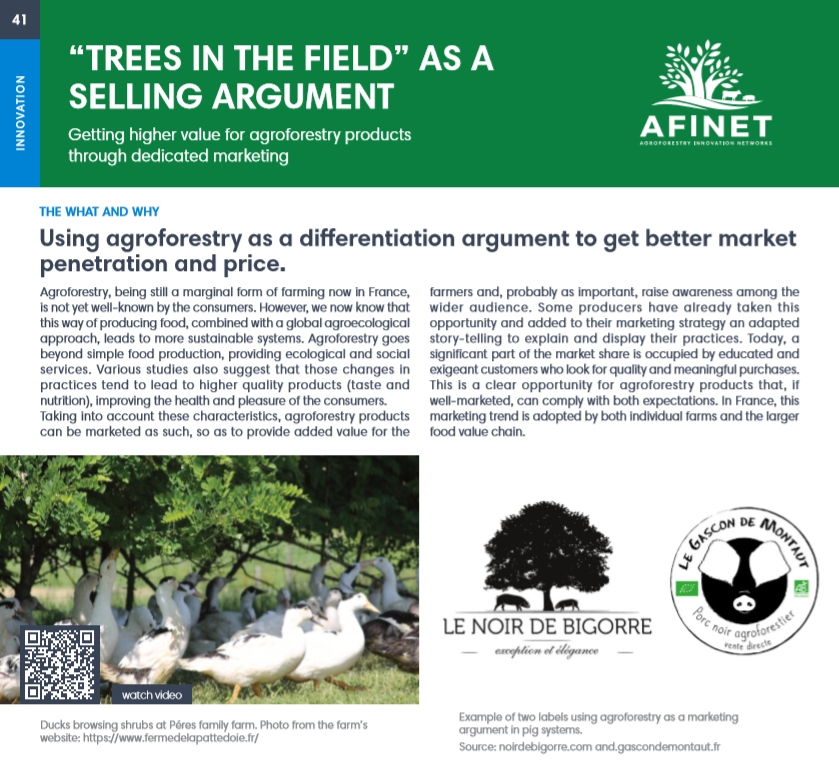 |
41 "Trees in the field" as a selling argument Agroforestry, being still a marginal form of farming now in France, is not yet well-known by the consumers. However, we now know that this way of producing food, combined with a global agroecological approach, leads to more sustainable systems. Agroforestry goes beyond simple food production, providing ecological and social services. |
|
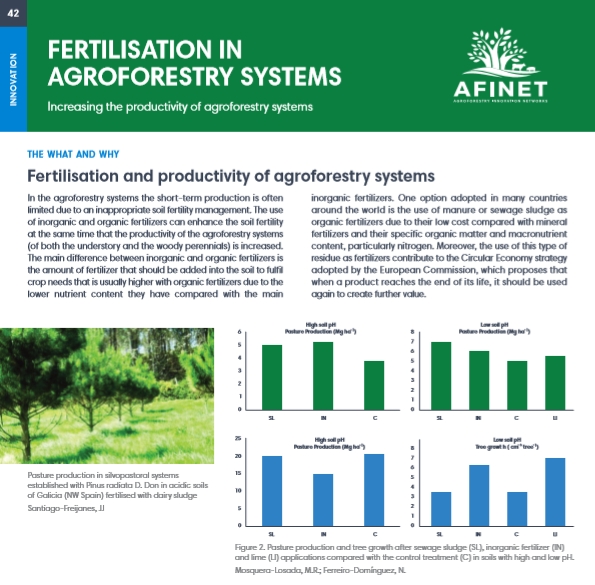 |
42 Fertilisation in agroforestry systems In the agroforestry systems the short-term production is often limited due to an inappropriate soil fertility management. The use of inorganic and organic fertilizers can enhance the soil fertility at the same time that the productivity of the agroforestry systems (of both the understory and the woody perennials) is increased. Download the high resolution print version (available soon) |
|
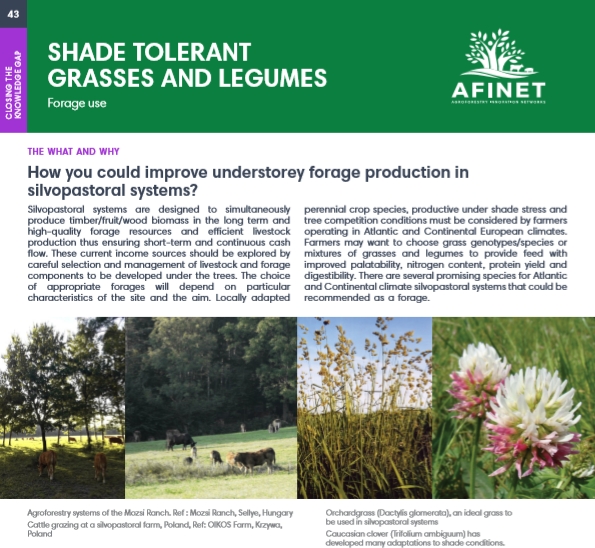 |
43 Shade tolerant grasses and legumes Silvopastoral systems are designed to simultaneously produce timber/fruit/wood biomass in the long term and high-quality forage resources and efficient livestock production thus ensuring short-term and continuous cash flow. Download the high resolution print version (available soon) |
|
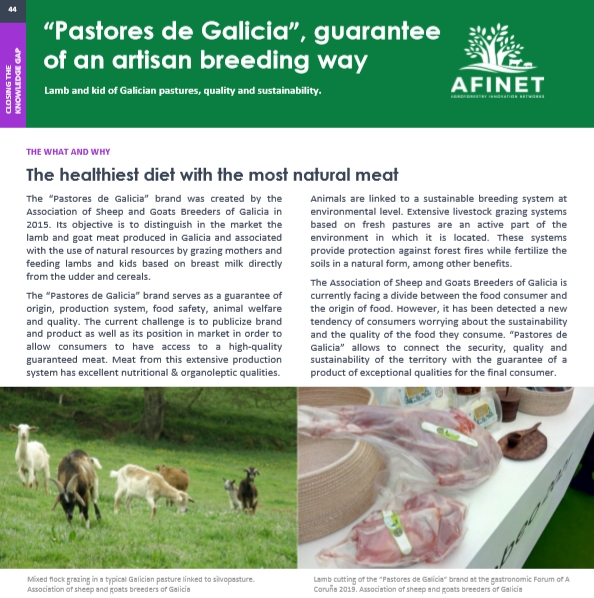 |
44 “Pastores de Galicia”, guarantee of an artisan breeding way The “Pastores de Galicia” brand was created by the Association of Sheep and Goats Breeders of Galicia in 2015. Its objective is to distinguish in the market the lamb and goat meat produced in Galicia and associated with the use of natural resources by grazing mothers and feeding lambs and kids based on breast milk directly from the udder and cereals. Download the high resolution print version (available soon) |
|
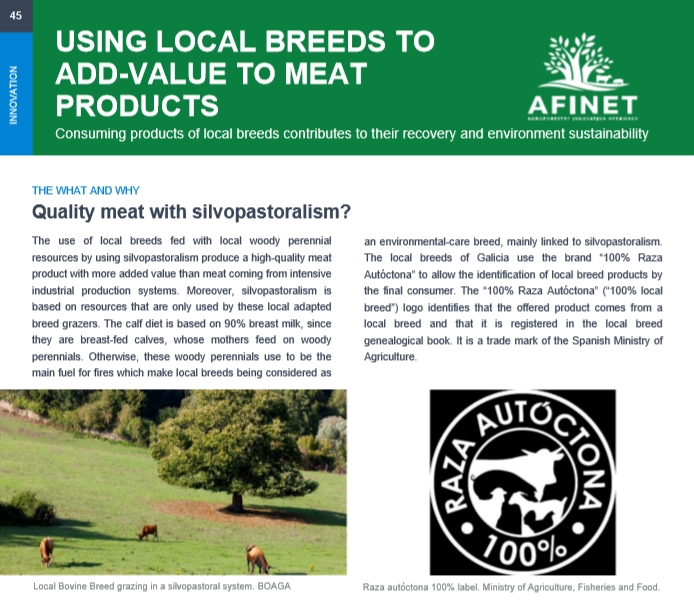 |
45 Using local breeds to add-value to meat products The use of local breeds fed with local woody perennial resources by using silvopastoralism produce a high-quality meat product with more added value than meat coming from intensive industrial production systems. Moreover, silvopastoralism is based on resources that are only used by these local adapted breed grazers. The calf diet is based on 90% breast milk, since they are breast-fed calves, whose mothers feed on woody perennials. Download the high resolution print version (available soon) |











